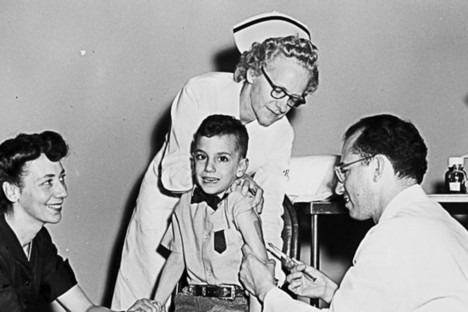 “Jonas Salk, right, inoculates his son against polio as his wife, left, looks on.” Source of caption and photo: online version of the WSJ quoted and cited below.
“Jonas Salk, right, inoculates his son against polio as his wife, left, looks on.” Source of caption and photo: online version of the WSJ quoted and cited below.
(p. W9C) “The Polio Crusade” will stir many memories with its account of successful efforts to eradicate the disease whose fear factor, we’re told, was second only to that of the atom bomb. (Monday 9-10 p.m. ET on PBS’s “American Experience” series, but check local listings.) The documentary also tells less-familiar, and sometimes disturbing, stories about the birth of modern fund-raising techniques, and old testing techniques.
. . .
Since the virus is spread most effectively by mouth, or through contact with byproducts of the intestinal tract, the improved hygiene of the 20th century should have led to a decrease in polio infections. The opposite happened. First in Europe and then in America, a disease which had barely registered on the medical radar began to strike more and more people, culminating in a U.S. record of nearly 58,000 cases in 1952.
The explanation for this seemingly counterintuitive symbiosis between cleanliness and disease is astonishing, yet simple. In a germier age, newborns were likely to be exposed to the polio virus very early in life, when they still had immunity conferred by their mother in the womb. When improved hygiene pushed back the time of exposure to a later age, or even to adulthood, many people were by then defenseless.
For the full review, see:
NANCY DEWOLF SMITH. “TELEVISION; In a Time of Plague.” The Wall Street Journal (Tues., JANUARY 30, 2009): W9C.
(Note: ellipsis added.)

